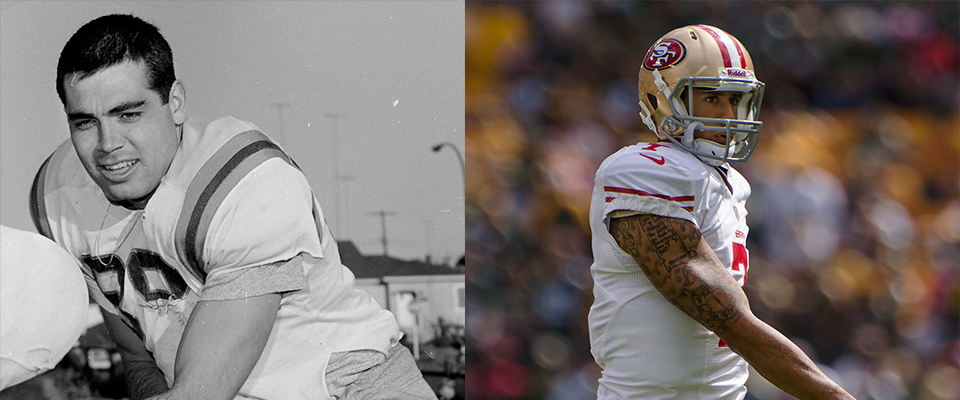For years, Joe Kapp fought the NFL. Now he’s tackling his memoirs.
Joe Kapp is finally ready to get it all down on paper—the whole thing, from his hardscrabble upbringing in Salinas to his heyday in the pros; from his first appearance in Memorial Stadium in 1956 to his return, 25 years later, as the head coach at his alma mater. Sitting down to talk on a recent summer day, the old quarterback patted his shoulder bag, which contained an iPad equipped with voice recognition software. Every day, he says, he tries to dictate a little more of his life’s story.
It hasn’t been easy. At 73, Kapp is still a live wire—spry, with a wicked sense of humor—but the struggle to remember has become hard, almost physical, work for him. Straining to retrieve an errant memory, he sometimes grimaces with the effort. An observer can’t help but be reminded of the younger Kapp, the famously hardnosed competitor, gritting his teeth behind the single horizontal bar of his facemask.
“My only problem is I can’t count to ten anymore,” Kapp responds when asked how he’s doing. “But hell, that’s the story with all us old guys.”
In July, when the NFL lockout was still in effect, I asked Kapp to discuss a particular chapter in his life’s story; namely, his eight-year legal battle with the NFL. Few fans will remember (nor likely cared much at the time) but Joseph R. Kapp v. the National Football League (1974) is one of the landmark cases in the ongoing struggle between professional sports club owners and their athletes—the owners and the owned.
The saga began in 1971, when Kapp was ordered to sign a standard player’s contract at the end of his first season with the Boston Patriots. Kapp’s attorney, John Elliot Cook, advised him not to; the contract was illegal, Cook said, and besides, he already had a valid contract with the Patriots—one Cook had negotiated personally. None of that concerned the NFL. When Kapp, then 33, refused to put his name on the dotted line, he was banished from training camp and, effectively, from the league. Like Curt Flood, the All-Star center fielder who took a similar stand against Major League Baseball, Kapp never played again. In response, he sued the NFL—all 26 teams—on anti-trust grounds.
That, at least, should sound familiar to today’s fans. In the lead-up to the 2011 season, the NFL once again faced an anti-trust suit. This time, the named plaintiffs were three of the league’s top quarterbacks—Drew Brees, Tom Brady, and Peyton Manning—and the suit was viewed as a weapon of last resort for the players association, which had to take the extraordinary step of decertifying as a union in order to invoke anti-trust.
In 1974, it was just Joe Kapp, acting on his own behalf: David taking aim at Goliath.
“Kapp was a rebel in a sport that didn’t have many of them at that time,” says Michael Oriard, a professor of English at Oregon State and the author of Brand NFL: Making and Selling America’s Favorite Sport. Oriard, who played center for the Kansas City Chiefs from 1970 to 1973, adds that the character of the NFL ownership has since changed considerably.
“At that time, the owners weren’t so much entrepreneurial as paternalistic. They were men accustomed to being seen as all-powerful. They didn’t see why they needed to share that power with players.” Kapp, Oriard continues, “was savvy and clearheaded in ways that the overwhelming majority of us were not.… In his own small way, he was challenging the grotesque one-sidedness of labor relations at the time.”
As it happened, Kapp prevailed in court, even as the players’ strike of the same year failed for lack of solidarity. Federal District Judge William Sweigert, ruling in the Ninth Circuit, issued a summary judgment in Kapp’s favor. The college draft, the option clause, and the Rozelle Rule—all means by which the league controlled a player’s mobility—were judged “patently unreasonable and illegal.” (Many of the gains Kapp won in court were later ceded by the players’ association. The college draft, for example, persists—not because it is legal, but because the players agreed to it in collective bargaining.)
In the subsequent trial over damages, however, Kapp lost badly. Under anti-trust law, plaintiffs stand to collect treble damages, but despite the fact that Joe had walked away from the nearly $450,000 remaining in his contract with the Patriots, the jury declined to award him a single cent. “The law is clear,” legal scholar Lon Sobel commented afterward. “The judge spelled that out. But it’s just as clear that the public lacks sympathy for professional athletes and their financial problems.” Kapp’s lawyers appealed, to no avail.
Perhaps more than anything, the jury’s decision highlighted the public’s schizophrenia regarding elite athletes, where adulation can turn to contempt in the space of a headline.
In 1969, Kapp became a kind of folk hero after turning down the Most Valuable Viking award. “There is no one most valuable Viking,” he insisted at the banquet, “just 40 most valuable Vikings” all playing their hearts out for 60 minutes. That “40 for 60” became the battle cry of the 1969 Vikings, whom Kapp led to a Central Division championship and a Super Bowl appearance.
That was also Kapp’s option year, at the end of which he was technically a free agent. But no teams called. Not one. Presumably, no team was willing to risk signing Kapp, because, according to the Rozelle Rule—sometimes called the “ransom rule”—they would have had to compensate the Vikings for the loss, either with players or draft picks. If the two teams couldn’t come to some accord on the matter, it was left to Commissioner Pete Rozelle—and Rozelle alone—to decide the terms.
As Kapp held out for a better offer than the one the Vikings had put on the table ($100,000 a year for three years, the same as his original contract three years earlier), the newspapers reported that Joe was demanding $1.25 million for five years, more than any player in the league. One commentator quipped that, while Kapp couldn’t tell you which Viking was most valuable, he seemed pretty clear as to who he considered most expensive.
And just like that, it was as if Joe Kapp the selfless leader had become Joe Kapp the greedy bastard, an image the defense attorneys exploited in the trial for damages. One of those attorneys was Joseph Alioto, who had recently served out his term as Mayor of San Francisco. Alioto, who liked to tool around town in his Rolls Royce, accused Kapp of harboring “a little dream of avarice.”
The old quarterback is not exactly keen to remember all this. “You know, that issue’s hard for me,” Kapp said when I first brought up his fight for free agency. “Let me tell you why: I’M NO VICTIM! … Now you read every interview I’ve ever done, they never get it right. So, that’s why I’m gonna write my book.”
To be sure, a lot of ink has been spilled on Kapp over the years. As his fame as a player grew, so did the list of epithets that attached to his legend. Because his mother was Mexican-American—a heritage Kapp is fiercely proud of—the sportswriters called him Super-Mex and Mr. Machismo. Sports Illustrated put him on the cover alongside the heading, “The Toughest Chicano.”
Toughness was indeed his calling card. Unlike most quarterbacks, Joe never ran out-of-bounds to dodge a hit. He’d either drop a shoulder and charge, or spring over would-be tacklers. They called him Jumpin’ Joe for his leaping passes and his propensity for vaulting over defenders, a practice the NFL cracked down on after Kapp’s knee caught a Cleveland Browns linebacker on the chin and left the man unconscious on the field.
When they weren’t thinking up new names for him, the writers made sport of Kapp’s uncouth style and seeming lack of prowess. Los Angeles Times columnist Jim Murray described him as “glacier fast” and compared his passes to “wounded airplanes looking for a place to land—in the dark.” A Newsweek scribe called Kapp a “big, belligerent example of everything a top pro quarterback isn’t supposed to be.”
“My whole image was not clásico—to say the least,” Kapp admits. “But I knew what I was doing.”
What he was doing, by and large, was winning. Time and again, Kapp transformed losing squads into victors, a pattern that started at Cal. In Kapp’s junior year, the Golden Bears went 1-9 on the season. The following year, they went to the Rose Bowl. It was virtually the same team, but as the sportswriter Ron Fimrite later remarked, “this one went to Pasadena principally because of Kapp’s ferocious determination.”
He kept it up in the pros, first in Canada, where he played for seven years, and then in the NFL. The B.C. Lions were 1-13-2 when Kapp came on board. Three years later, they were Grey Cup champions. The Vikings were sixth in their division when Kapp joined the franchise. Three years later, they were in the Super Bowl.
The record of turnarounds didn’t seem to impress Miami Dolphins head coach Don Shula, one of the witnesses who testified at Kapp’s damages trial. On the stand, Shula judged Kapp to be far inferior to the legendary Johnny Unitas, about on par with the largely forgotten Earl Morrall—two quarterbacks Shula had coached at the Baltimore Colts. He further opined that, whereas Kapp required a top-notch offensive squad to be effective, a quarterback like Unitas was capable of lifting even mediocre players to the championship level.
The assessment still galls Kapp, whose Vikings in fact routed Shula’s Colts in 1968, 53–14—a game in which both Unitas and Morrall played and struggled while Kapp threw for a record seven touchdowns. Seven touchdowns! “And against who?” Kapp booms. “They were the Super Bowl team! How many Hall of Famers were on that team? And Shula says Unitas was a quarterback who could get his players to play better? How many cheeks do I have to turn?”
A notorious fighter both on and off the field, it’s not clear that Kapp ever turned the other cheek. Still, he insists, he never started a fight in his life—and that includes his fight with the NFL.
Earlier in this story, I said the trouble started in 1971, at the Patriot’s training camp. Actually it goes back further. Kapp recalled for me the time Pete Rozelle voided Kapp’s contract with the Houston Oilers. It was 1967 and Joe had negotiated with the Oilers during his option year in British Columbia, but the Commissioner quickly stepped in to put the kibosh on the deal. Kapp says, “You’ve been avoided, I know, but have you ever been voided? Now that, that’s a real cuss maker.” Shortly thereafter, Kapp was informed that if he wanted to play in the NFL, he would be doing it in Minnesota.
Going back even earlier, Kapp points to the strange circumstances surrounding his position in the 1959 college draft. A consensus All-American at Cal, fifth in the voting for the Heisman Trophy, he was not drafted until the 18th round—209th overall—by the Washington Redskins, whom Kapp claims never even contacted him. Meanwhile, Randy Duncan, his opposing quarterback in the Rose Bowl, was picked first. Kapp cocks an eyebrow and asks, “What does it mean?”
Kapp has some ideas about what it means, but for that you’ll have to wait for the book.
As our interview wound down, I asked him if he had a title in mind for the autobiography. He threw out a couple of possibilities, laughing a little dismissively at each one: Whose Ball Is It? and Terms of Employment.
“But no,” he said finally, “one of the first things you do when you sit down is try to answer the question, ‘Why write a book?’ And then the title that comes to mind for me is Fuck You.” He swears it will be a comedy.





















